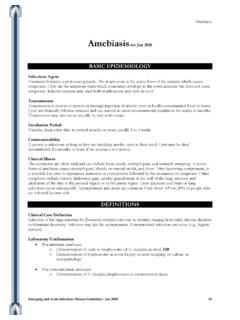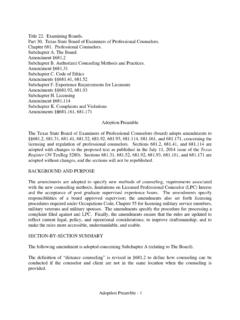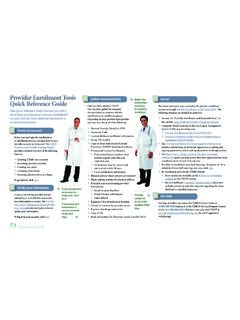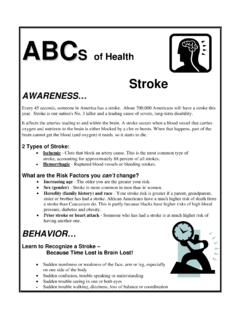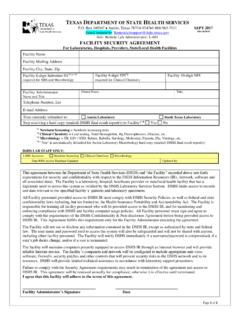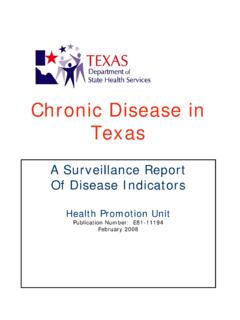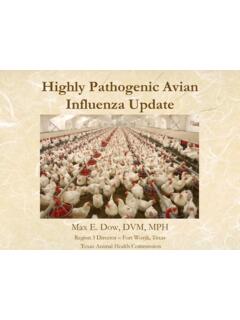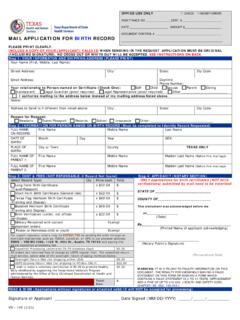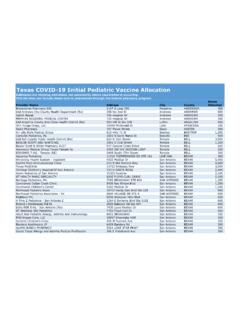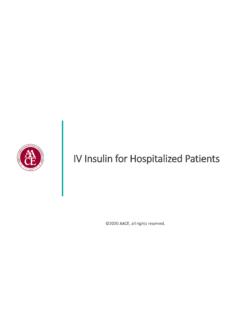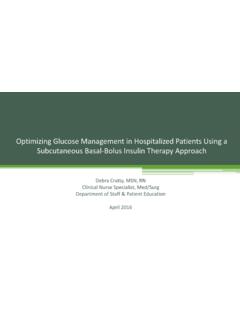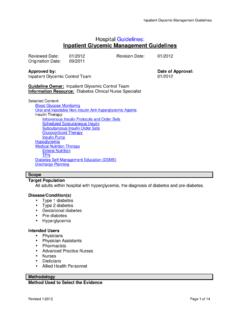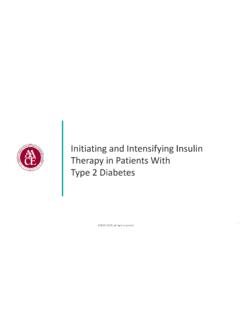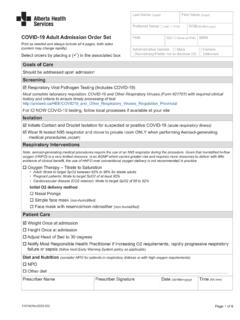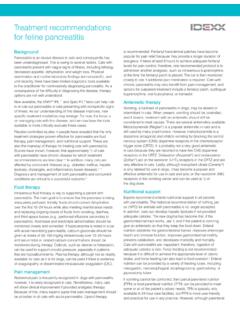Transcription of Diabetes treatment algorithms Iv Insulin Infusion Protocol ...
1 This algorithm is not intended to be used for those individuals with type 1 Diabetes , diabetic ketoacidosis or hyperglycemic hyperosmolar range for gly CemiC Control: 80 140 mg/dl ( generally 110 mg/dl)1. Standard drip 100 units/100 mL NaCl. Approved IV insulins include Regular, aspart and glulisine 2. Start IV Insulin therapy when glucose is above target range. Insulin infusions should be discontinued when a. Patient has no history of Diabetes and is receiving <1 Unit/hour b. Patient receives 1st dose of SC basal + bridging dose of fast analog or R (see #10)3. Bolus dose and Initial Infusion rate: Divide initial glucose level by 100, then round to nearest units for bolus AND initial Infusion rate Examples: 1) Initial glucose=326 mg/dL: 326 100= , round to : IV bolus units + start Infusion @ units/hour 2) Initial glucose=174 mg/dL: 174 100= , round to : IV bolus units + start Infusion units/hour4.
2 Intravenous Fluidsu Most patients will need 5 10 g glucose per hour D5W or D5W NS at 100 200 mL/hour or equivalent (TPN, enteral feeding, etc.)5. Adjusting the Infusion :u Algorithm 1: Start here for most Algorithm 2: For patients not controlled with Algorithm 1, or start here if s/p CABG, solid organ or islet cell transplant, receiving glucocorticoids etc. or patient with Diabetes receiving >80 units/day of Insulin as an Algorithm 3: For patients not controlled on Algorithm 2. NO PATIENT STARTS HERE without authorization from the endocrine Algorithm 4: For patients not controlled on Algorithm 3. NO PATIENT STARTS HEREIv Insulin Infusion Protocol for Critically-Ill Adult patients in the ICU SettingDiabetes treatment algorithmsrevised 10/25/07publication # 45-120631 of 4 iv Insulin Infusion Protocol for critically-ill Adult patients in the icu setting revised 10/25/07 See disclaimer at 1 Algorithm 2 Algorithm 3 Algorithm 4 Glucose units/h Glucoseunits/h Glucose units/hGlucose units/h<60 = Hypoglycemia (See #8 for treatment )
3 <70 Off<70 Off<70 Off<70 Off70 10 10 10 9170 10 1191110 1192110 1193120 1491120 1493120 1495150 1792150 1794150 1797180 2092180 2093180 2095180 2099210 2392210 2394210 2396210 23912240 2693240 2695240 2698240 26916270 2993270 2996270 29910270 29920300 3294300 3297300 32912300 32924330 3594330 3598330 35914330 35928>36 06>36 012>36 016>36 0326. Moving from Algorithm to Algorithm:u Moving Up: When glucose remains outside the target range after titrating insulinu Moving Down: When glucose is <70 mg/dL x 2 or decreases >60 mg/dl in 1 hour7. Patient Monitoring:u Hourly venous (lab) determinations until glucose <450 mg/dL; then capillary glucose (finger sticks) q 1hour until glucose is within goal x 4 hours; then every 2 hours x 4 hours; If stable, decrease monitoring to every 4 hoursu Hourly monitoring indicated for critically ill patients even if the glucose is stableu In hypotensive patients (BP <80/60), capillary glucose values may be inaccurate.
4 Obtain venous blood for glucose determinationsu If any of the following occur, temporarily resume hourly glucose monitoring, until glucose is again stable (2 3 consecutive values within target range): Any change in Insulin Infusion rate Significant changes in clinical condition Starting or stopping pressor or steroid therapy Starting or stopping dialysis Starting, stopping or changing rates of TPN, PPN or tube feedings8. treatment of Hypoglycemia (Glucose <60 mg/dL) u Discontinue Insulin drip ANDu Give D50W IV Glucose 40 60 mg/dL g (1/2 amp) Glucose <40 mg/dL g (1 amp)u Recheck glucose every 15 30 minutes and repeat D50W IV as above. Restart Insulin drip, one algorithm lower, when glucose >80 mg/dL x 2 Diabetes treatment algorithms2 of 4 iv Insulin Infusion Protocol for critically-ill Adult patients in the icu setting revised 10/25/07 See disclaimer at Notify the physician:u For patients not responding to Algorithm 1 or For hypoglycemia which has not resolved after administration of D50W IV and discontinuation of the Insulin drip10.
5 Transition from IV Insulin to SC Insulin : Basal-Analog Method a. Calculate Total Daily Dose (TDD) for subcutaneous Insulin TDD = Infusion rate/h x 20h b. First dose SQ Insulin includes [basal Insulin + bridging dose aspart, glulisine, lispro or R] x 1 1. If patient will begin eating give: Half TDD as basal glargine, detemir* or NPH* Plus Bridging Insulin ** @ 10% of basal Insulin dose Stop IV Insulin Continue primary 2. If patient will continue NPO, TPN or tube feeding give: All TDD as basal glargine, detemir* or NPH* Plus Bridging Insulin ** @ 5% of basal Insulin dose Stop IV Insulin and continue primary c. Proceed to Inpatient management of Insulin in the Non-Critical Care Setting algorithm for management of daily basal Insulin , prandial + supplemental Insulin ** No evidence-based data on inpatient transition from Insulin to detemir.
6 If detemir is selected, expect to use at least 25% greater dose than glargine. If the dose of detemir is < units/Kg, use half bid. If NPH is used as a basal Insulin the dose is 2/3 of the TDD (whether or not the patient is eating) and is distributed bid as 2/3 and 1/3 or may be divided equally and given q 6h. ** R (regular Insulin ) is not preferred as a bridging or prandial insulinDiabetes treatment algorithms3 of 4 iv Insulin Infusion Protocol for critically-ill Adult patients in the icu setting revised 10/25/07 See disclaimer at : 1. Garber AJ, Moghissi ES, Bransome ED Jr., et al; American College of Endocrinology Task Force on Inpatient Diabetes Metabolic Control. American College of Endocrinology position statement on inpatient Diabetes and metabolic control. Endocr Pract.
7 2004;10 (Suppl 2):4 Bode BW, Braithwaite SS, Steed RD, et al. Intravenous Insulin Infusion therapy: indications, methods, and transition to subcutaneous Insulin therapy. Endocr Pract. 2004;10 (Suppl 2):71 Goldberg PA, Siegel MD, Sherwin RS, et al. Implementation of a safe and effective Insulin Infusion Protocol in a medical intensive care unit. Diabetes Care. 2004;27(2):461 Vora AC, Saleem TM, Polomano RC, et al. Improved perioperative glycemic control by continuous Insulin Infusion under supervision of an endocrinologist does not increase costs in patients with Diabetes . Endocr Pract. 2004;10(2):112 Chaudhuri A, Janicke D, Wilson MF, et al. Anti-inflammatory and profibrinolytic effect of Insulin in acute ST-segment-elevation myocardial infarction. Circulation. 2004;109(7):849 Trence DL, Kelly JL, Hirsch IB.
8 The rationale and management of hyperglycemia for in- patients with cardiovascular disease: time for change. J Clin Endocrinol Metab. 2003;88(6):2430 Lien L, Spratt S, Woods Z, et al. A new intravenous Insulin nomogram in intensive care units improves management of persistent hyperglycemia (Abstract). Diabetes . 2003;52 (Suppl 1) Preiser JC, Devos P, Van den Berghe G. Tight control of glycaemia in critically ill patients . Curr Opin Clin Nutr Metab Care. 2002;5(5):533 Markovitz LJ, Wiechmann RJ, Harris N, et al. Description and evaluation of a glycemic management Protocol for patients with Diabetes undergoing heart surgery. Endocr Pract. 2002;8(1):10 Van den Berghe G, Wouters P, Weekers F, et al. Intensive Insulin therapy in the critically ill patients . N Engl J Med. 2001;345(19):1359 Hirsch IB.
9 Insulin therapy for Diabetes : is the future now? Clin Diabetes . 2001;19:146 Furnary AP, Zerr KJ, Grunkemeier GL, et al. Continuous intravenous Insulin Infusion reduces the incidence of deep sternal wound infection in diabetic patients after cardiac surgical procedures. Ann Thorac Surg. 1999;67(2):352 Malmberg K, Ryden L, Efendic S, et al. Randomized trial of Insulin -glucose Infusion followed by subcutaneous Insulin treatment in diabetic patients with acute myocardial infarction (DIGAMI study): effects on mortality at 1 year. J Am Coll Cardiol. 1995;26(1):57 Woo J, Lam CW, Kay R, et al. The influence of hyperglycemia and Diabetes mellitus on immediate and 3-month morbidity and mortality after acute stroke. Arch Neurol. 1990; 47(11):1174 Watts NB, Gebhart SS, Clark RV, et al. Postoperative management of Diabetes mellitus: steady-state glucose control with bedside algorithm for Insulin adjustment.
10 Diabetes Care. 1987;10(6):772 Pittas AG, Siegel RD, Lau J. Insulin therapy for critically ill hospitalized patients : a meta-analysis of randomized controlled trials. Arch Intern Med. 2004;164(18) Desantis AJ, Schmeltz LR, Schmidt K Inpatient management of hyperglycemia : The northwestern experience. Endocrine Practice. 2006;12(5) Donaldson S, Villanuueva G, Rondinelli L, Baldwin D. Rush university guidelines and protocols for the management of hyperglycemia in hospitalized patients . Elimination of the sliding scale and improvement of glycemic control throughout the hospital. The Diabetes Educator. 2006;32(6) Hirsch IB. An endocrinologist s view on the practical use of Insulin . Insulin . 2006;1(Suppl A) Novo Nordisk detemir monograft, 2005. Studies 1337,1530, NNTTT, treatment algorithms4 of 4 iv Insulin Infusion Protocol for critically-ill Adult patients in the icu setting revised 10/25/07 See disclaimer at
